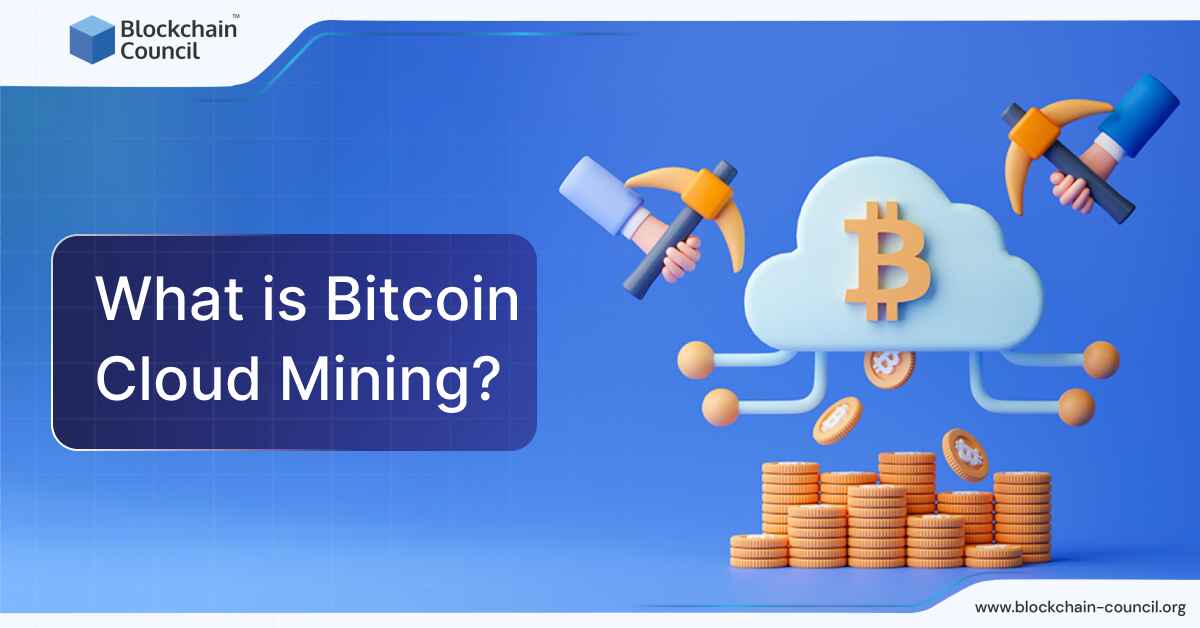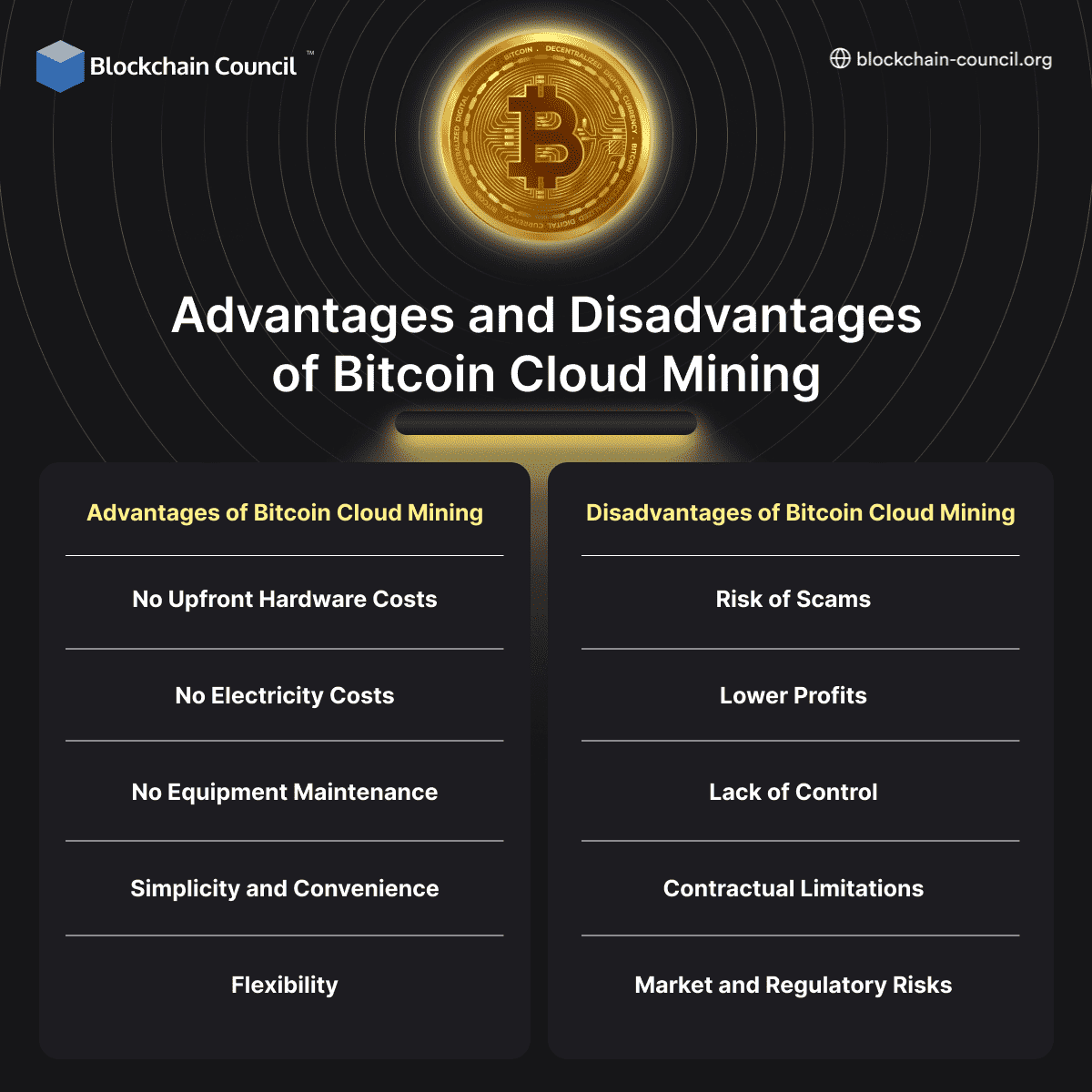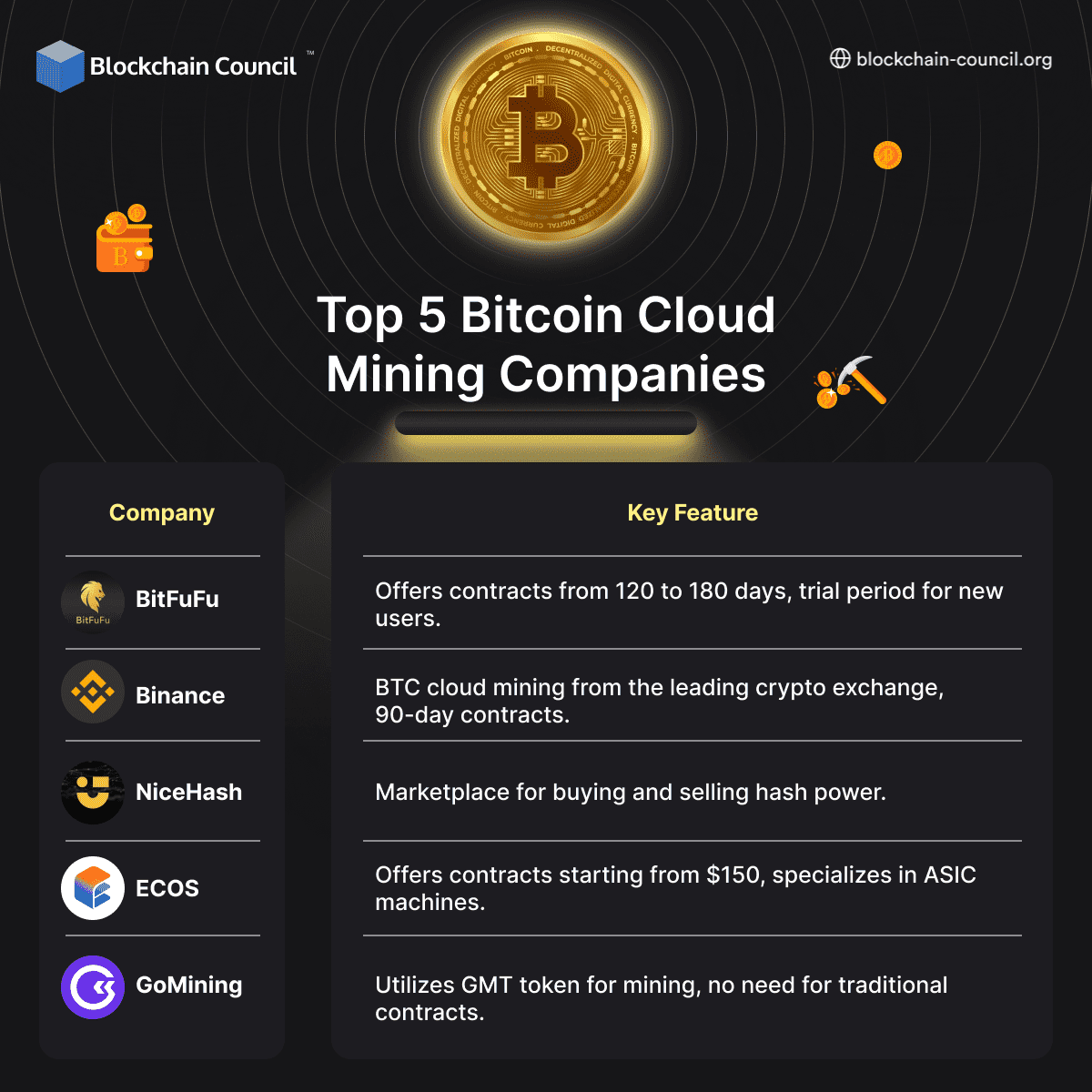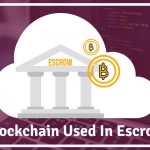
- Blockchain Council
- September 02, 2024
What is Bitcoin Cloud Mining?
Bitcoin cloud mining is a popular way for people to earn bitcoins without investing a lot. It allows miners to earn Bitcoin without buying or setting up expensive mining hardware. Instead, you need to lease the equipment from a data center. You can also rent computing power from organizations that own mining equipments.
In simple terms, Bitcoin cloud mining firms allow people to remotely participate in Bitcoin mining in return of a fee. All you have to do is open an account with the firm. The cost of the hardware and electricity are on the mining firm. The user and the renting company share the reward once the rented mining hardware mines a block.
The term cloud mining comes from cloud computing. You might already know, cloud computing is the use of remote servers to deliver computer services. In this process, local servers are not used to store or process data over the internet or “the cloud.”
In cloud computing, users can rent computing resources from cloud service providers instead of owning them. And the term “cloud” symbolizes the idea of accessing the services remotely over the internet. Just like you can see the clouds from a distance, free and not tied to one place.
Similarly, Bitcoin cloud mining allows you to mine on “the cloud” without having to own any mining equipment.
Once you agree to become a Bitcoin cloud miner, you are put into a mining pool. Here’s how Bitcoin cloud mining works.
How Does Bitcoin Cloud Mining Work?
Cloud mining works on complex mining hardware. Mining companies operate large data centers. They set up special mining equipments, also known as mining rigs.
Mining rigs are advanced computer systems built specifically for crypto mining. They can perform high-performance computation with ease that won’t be possible on the computers we use at home. Mining rigs are typically made of the following components:
- GPUs (Graphics Processing Units)
- ASICs (Application-Specific Integrated Circuits)
- Motherboard
- CPU (Central Processing Unit)
- Power Supply Unit (PSU)
- Memory (RAM)
- Storage (e.g. SSDs and HDDs)
- Cooling System
So, to understand how cloud mining works, you need to have a basic idea of how traditional crypto mining works. In the Proof-of-Work (PoW) mechanism, miners solve cryptographic puzzles to validate a transaction and secure the whole network. In return they earn a reward. Now the difference between traditional crypto mining and cloud mining is, in traditional crypto mining you use your own mining hardware. However, as mentioned earlier, in cloud mining for crypto like Bitcoin, you use the mining firm’s hardware for the same process instead of using your personal equipment.
Now, you may have heard, mining includes complex mathematical problems that need to be solved. This is actually wrong. Mining is more of a race than a math test. During a mining process, minsers try to guess a special number. This number is known as the “target.”
Usually miners try to guess a number that is either exactly equal to or less than the target number. This target number is chosen from a range between zero and a very large number (2256). The target value is determined from the difficulty level of the mining process.
When miners guess a number, they’re hoping it’s smaller than or equal to this target number. They shoot their shots until one miner gets the target right. All the miners are in the race to guess the target first. Because, whoever guesses it first, gets to add a new block of transaction to the Blockchain. And in return, they get rewarded with cryptocurrencies like Bitcoin.
So where is the math?
The SHA-256 algorithm is the math part. Hashing algorithms like this involve complex mathematical problems but that’s not a headache for the miners. This is because the computer processors solve it in less than a second.
This is the same way Bitcoin cloud mining works. Renting computing power of a cloud mining firm means renting a portion of their total hash rate. This hash rate measures the total computational power of the mining hardware you are renting. It indicates how many attempts the hardware can make to solve a mining problem on a block per second. If you rent more hash rate, your chances to win mining rewards will increase as well.
Bitcoin Cloud Mining Models
There are two cloud mining models for crypto like bitcoins:
Hosted Mining
In this model, you rent a mining package or a specific mining rig from the mining firm. The mining firm homes and maintains the mining rig in its data center. You will have control over the rig you rent. You can also manage it remotely. In hosted mining, you have more control over the hardware you are renting. Plus, you need not worry about its maintenance.
Leashed Hash Power
In this crypto cloud mining model, you don’t rent the whole mining rig, but a share of computing power from a larger mining pool provided by the mining firm. Mining pool participants come together with their computation resources to mine cryptocurrencies like Bitcoin. The share of rewards in this case is lower than that of hosted mining.
However, this model requires less investment and technical knowledge to start with. Further, you need to pay a service fee for using the mining rig and share your reward with others in the mining pool. In the leashed hash power model, the rewards are distributed among mining pool participants in proportion to the amount of hash rate they contributed in a mining process.
How to Start Bitcoin Cloud Mining?
We have learned what Bitcoin cloud mining is and how it works. Now let’s have a look at the step-by-step process on how to start Bitcoin cloud mining:
Step 1: Choose a Cloud Mining Company
The first step is choosing a reputable cloud mining company. It’s crucial to pick a company that is reliable. Companies like Ecos, INC Crypto, and ARK Mining have good reputations in the market. Remember, there are many scams out there. Therefore, you must do thorough research before choosing the cloud mining company to mine bitcoins or other cryptocurrencies.
Step 2: Selecting a Mining Package
Next, you need to decide how much computing power you want to rent. The more you rent, the more you might earn, but the cost will be higher. As we already discussed, you need to choose between the two cloud mining models mentioned above.
Step 3: Paying for the Service
Once you have chosen the suitable mining package, it’s time to pay. You need to pay the mining firm after signing the contract. Usually you will enter a contract with the cloud mining provider that specifies the amount of hash rate you are renting, the duration of mining operation, as well as other terms like fees, share in rewards, etc. Mining companies usually accept payments in both cryptocurrency and fiat currency. However, it depends on the company you are choosing and the type of service you are going for.
Step 4: Mining Starts
You need not do anything in this step. The company mines cryptocurrencies like Bitcoin on your behalf using the computing power you have rented. The mining firm handles the maintenance and technical aspects.
Step 5: Receive Mining Rewards
Rewards coming up from the mining process are distributed as per the models explained above. If you have chosen the hosted mining model, then your share of reward will be higher. If you have chosen the leashed hash power model, then your share of reward will depend on the amount of your rented computing that was used in the mining process. You will need a crypto wallet to receive your mining rewards.
Advantages & Disadvantages of Bitcoin Cloud Mining
Advantages of Bitcoin Cloud Mining
- No Upfront Hardware Costs: One of the biggest benefits of Bitcoin cloud mining is no upfront hardware costs. There is no need for the purchase of mining rigs that normally cost a lot.
- No Electricity Bills: The process of crypto mining uses a huge amount of electricity. In the case of cloud mining, you need not worry about electricity bills. The mining firm bears the power usage costs for the period of mining.
- Equipment Maintenance: All care and repairing of the mining hardware is on the service provider.
- Simple and Easy: One does not even need any technical know-how or experience to get started on the mining process. You just rent the service and leave the rest to the service provider.
- Flexibility: Some of the services that offer cloud mining come with flexible plans. Therefore, the user can choose or change the plans for different cryptocurrencies, given the market conditions.
Disadvantages of Bitcoin Cloud Mining
- Scam Risk: The cloud mining space is infamous for scams. It is pretty difficult to understand whether one or another service of cloud mining is genuine, and a great number of investors have already suffered from fake schemes.
- Lower Profits: As you are paying for a service, it implies that a part of your mining rewards will go to the provider. This could reduce your potential profits compared to direct mining.
- Lack of Control: Often, you have little control over the mining process. The hardware, electricity use, and even what cryptocurrency is mined are all decided by the company handling the cloud mining process.
- Contractual Limitations: The very terms of the contract from the cloud mining aren’t all friendly. Some may have a long period, costly fees, or conditions that would not easily allow one to be profitable.
- Market Risk: The prices of cryptocurrency constantly change. In the event of a significant drop in the price of Bitcoin, the mined cryptocurrency generated under your cloud mining contract may not be sufficient to cover the cost.
- Regulatory Risks: The regulatory environment of cryptocurrencies including Bitcoin is changing. Changes in regulations may impose on profitability or even the legality of operations on cloud mining.
Important Metrics to Consider
- Hash rate
- Energy consumption in mining
- Cost per hash
- Mining difficulty
- Block reward
- Mining pool fees
- Price of the cryptocurrency
Top 5 Bitcoin Cloud Mining Companies
Conclusion
As we’ve seen throughout this article, Bitcoin cloud mining offers an easy and accessible path for individuals to participate in cryptocurrency mining without the need for significant investment in hardware or technical expertise.
It presents a unique opportunity to earn Bitcoin and contribute to the network’s security. However, it comes with its own set of considerations. Like any other investment, it’s important to do your homework, assess the risks, and consider the potential rewards before you step into cloud mining.
Staying informed and selecting reputable providers will help you succeed in this space successfully. With this article as your starting point, you are now set to start your journey as a Bitcoin cloud miner!
FAQ’s
What is Bitcoin cloud mining?
- Bitcoin cloud mining is a way to earn Bitcoin without owning mining hardware.
- You lease computing power from a company’s data center to mine Bitcoin remotely.
- The company handles hardware maintenance and electricity costs.
- Rewards are shared between you and the company based on your agreement.
How does Bitcoin cloud mining work?
- You choose a reputable company and select a mining package.
- After paying for the service, the company mines Bitcoin on your behalf using the rented computing power.
- Rewards are distributed based on the model chosen and your rented computing power.
- You need a crypto wallet to receive your mining rewards.
What are the advantages of Bitcoin cloud mining?
- No upfront hardware costs.
- No electricity bills; the company bears the power usage costs.
- Equipment maintenance is handled by the service provider.
- Simple and easy process; no technical knowledge required.
What are the risks of Bitcoin cloud mining?
- Scam risk; the cloud mining space is notorious for scams.
- Lower profits as part of your rewards go to the provider.
- Lack of control over the mining process; decisions are made by the company.
- Regulatory changes may affect profitability or legality of operations.







































































 Guides
Guides News
News Blockchain
Blockchain Cryptocurrency
& Digital Assets
Cryptocurrency
& Digital Assets Web3
Web3 Metaverse & NFTs
Metaverse & NFTs
